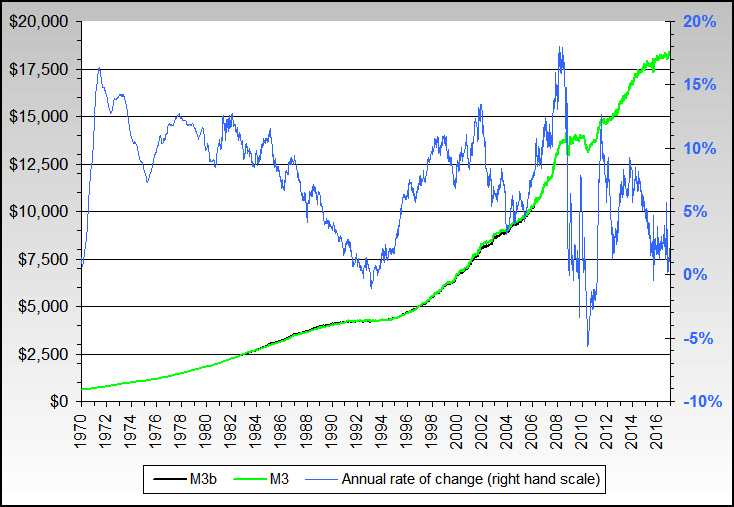 17 juli 2008, 16:31
17 juli 2008, 16:31
|
#6
|
|
Secretaris-Generaal VN
Geregistreerd: 26 september 2003
Locatie: van Lissabon tot Vladivostok
Berichten: 31.233
|


LT-evolutie van de M3-groei: Grafiek
Citaat:
Professor Charles Goodhart - (Goodhart’s Law, ex Monetary Policy Committee, and now Olympian sage at the LSE) - is too polite to say that the Federal Reserve has made an utter hash of the US economy by slashing interest rates to 2%. But that is clearly what he thinks.
“I would have done exactly the same as Bernanke given the financial crisis they were in,” he told me this week, sticking to the “mutual admiration” etiquette of central bankers. Then comes the sting.
“The M3 money supply is rising very rapidly indeed. There has been a very expansionary increase in the size of balance sheets,” he said.
The professor warned that yields on 10-year Treasuries (now 3.79pc) have shot up so much on inflation fears since the Fed bail-out in March that the effect risks short-circuiting the whole monetary rescue. “They may find that they don’t benefit after all from cutting rates,” he said...
The Fed may now be trapped. The argument is that the US 10-year rate - set by market forces, and increasingly by the actions of Chinese and Mid-East governments - is the key price setter for the US housing market and corporate debt. Mess with bond vigilantes at your peril.
Mr Goodhart warns that the Fed’s “ideological” attachment to core inflation - which strips out food and energy - could lead them up the creek this time.... “The Fed thinks that headline inflation (3.9pc) will come back down to core inflation, but this time core may go up to headline,” he said...
I flag these comments because they touch on the most neuralgic issue of the day. My own view - if I dare dissent from the professor - is that the M3 surge is a false alarm. Needless to say, the Fed has not helped matters by abolishing the data.
Paul Ashworth, US economist for Capital Economics, has reconstructed the M3 figures using the old Fed model. They show that the M3 growth rate has jumped from 8.1pc to 14.9pc since the credit crunch began in August - high, but nothing like the claims of 30pc that are bandied around.
This rise is almost entirely due to a “bearish” flight from stocks and suchlike. Nervous investors have parked their wealth in money funds for safety until the crisis blows over. These money funds are distorting the M3 data (as Prof Goodhart also recognizes).
“Everybody keeps saying the Fed is dropping money from helicopters and flooding the economy with liquidity, but it is not true. All that is happened is that the precautionary demand for money has gone up. That is not inflationary in any way,” said Mr Ashworth.
Indeed, if you look at the narrower M1 money supply, which the Fed does control, it has actually fallen 0.7pc over the last year. The monetary base is contracting.
This chart from the Saint Louis Fed sent to me today by a reader came as a shock. The slide is getting worse. Perhaps that is why gold is down $125 an ounce from its peak in March.
It reinforces my fear that we are heading into a deflationary crunch. No doubt the Fed, ECB, the Bank of England, et al, will ultimately flood the system with money and set off another asset bubble. We are not there yet.
So let me throw it open to any readers who have a view: do we really face galloping inflation in the Atlantic and Japanese economies (still almost 60pc of world GDP), or is deflation lying in wait?
Should we be worried about rising M3?
|
M3 groei tussen 15 en 20%
Federale bank intrestvoet 2%
PPI inflatie index rond de 10%
 |

|

|